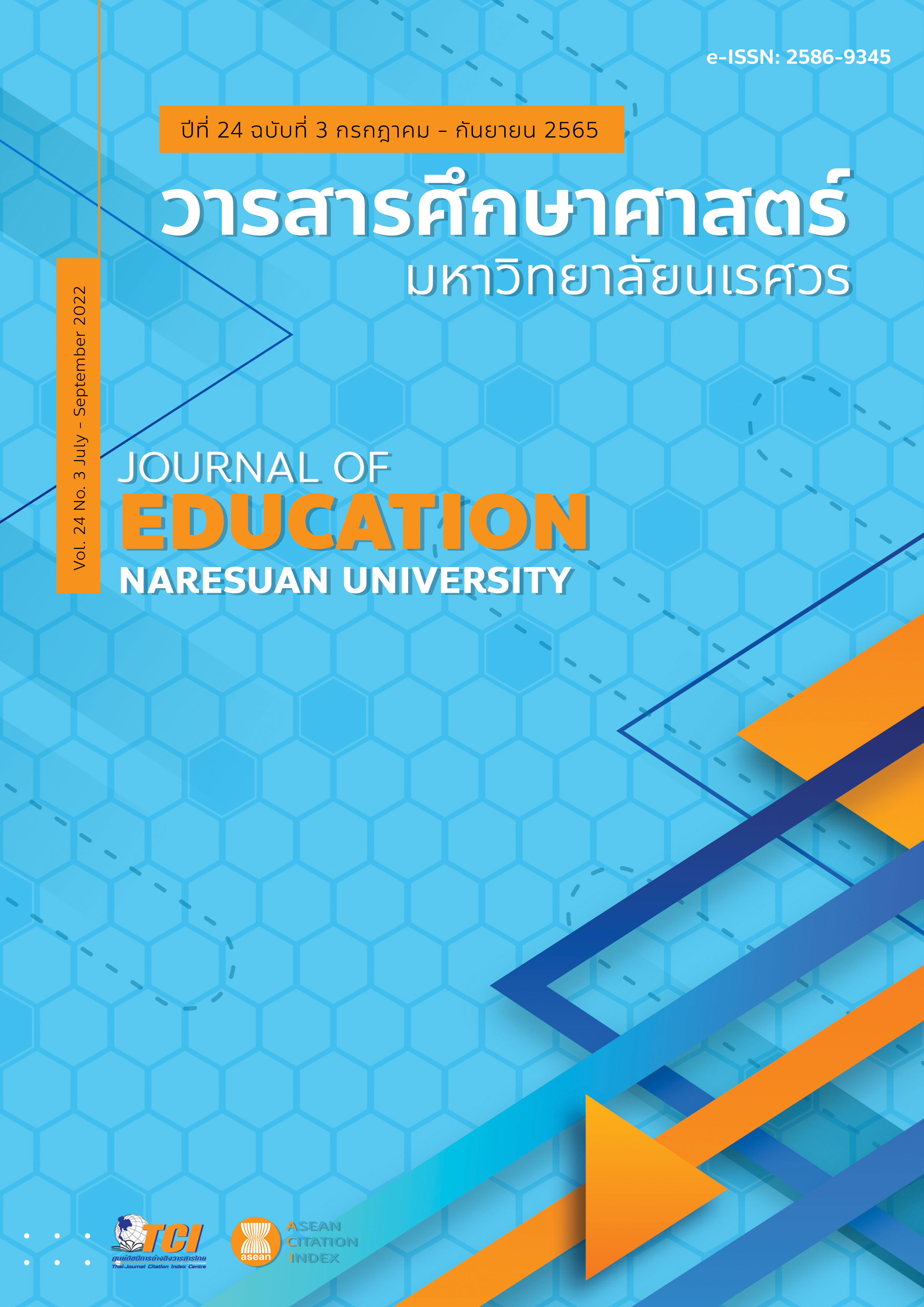MIXED REALITY AND VARK LEARNING STYLES IN BBL การเรียนแบบผสานความจริงด้วยสื่อกับรูปแบบการเรียนรู้ VARK โดยใช้สมองเป็นฐาน
Main Article Content
Abstract
The natural learning process that is relies on the input of information through brain functions by manipulating information received through the senses, making it the thinking process, which is often used to enhance learning to increase efficiency. The students can learn according to their own potential. Moreover, learners have different styles of learning for each individual. Some people can learn better by seeing (Visual), listening /talking (Aural), reading /writing (Read /Write) or practice (Kinesthetic) along with Mixed Reality (MR) technology, such as Virtual Reality (VR), Augmented Virtual (AV) and Augmented Reality (AR). Therefore, these are the alternatives for the development of suitable learning styles for learners in the digital age (digital native), which is based on Mixed Reality and VARK learning styles in BBL. Furthermore, it can divide into four categories: VR Problem, AV Discussion, AR Design Solution, and AR Take Action. In addition, the processes encourage the learners to have ideas, imagination, emotions, and significant skills, which connected from their own previous experiences to new experiences. And these complements creative thinking based on the happiness and freedom learning in BBL, the foundation of 21st century learning management, which based on the learner that is the centre of learning.
Article Details

This work is licensed under a Creative Commons Attribution-NonCommercial-NoDerivatives 4.0 International License.
The owner of the article does not copy or violate any of its copyright. If any copyright infringement occurs or prosecution, in any case, the Editorial Board is not involved in all the rights to the owner of the article to be performed.
References
Albert, A., Hallowell, M. R., Kleiner, B., Chen, A., & Golparvar-Fard, M. (2014). Enhancing construction hazard recognition with high-fidelity augmented virtuality. Journal of Construction Engineering and Management, 140(7), [04014024]. https://doi.org/10.1061/(ASCE)CO.1943-7862.0000860
Caine, R. N., & Caine, G. (1990). Understanding a brain based approach to learning and teaching. Educational Leadership, 48(2), 66-70.
Chaiwongsa, Y. (2015). The development of a learning activities model based on the concepts of brain-based learning and scaffolding for Thai language reading and writing abilities enhancement of primary school students. Sakon Nakhon: Sakon Nakhon Rajabhat University. [in Thai]
Chantravaratit, L. (2019). A learning process integrating Thai language skills for creating Learner's wisdom (Research Report). Nakhon Pathom: Nakhon Pathom Rajabhat University. [in Thai]
Fleming, D. N. (2012). Facts, fallacies and myths: VARK and learning preferences. Retrieved March 3, 2020, from https://vark-learn.com/wp-content/uploads/2014/08/Some-Facts-About-VARK.pdf
Fleming, N. D., & Mills, C. (1992). Not another inventory, rather a catalyst for reflection. To Improve the Academy, 11(137), 140-141.
Guttantag, D. A. (2011). Virtual reality (Sayamol WittayaTanarattana, Trans). Bangkok: TAT. [in Thai]
Jansook, N., Jansook, C., & Weerawatthanodom, N. (2017). A study of VARK learning styles of first year nursing students at Boromarajonani College of Nursing, Chainat. Naresuan Research Conference 13 (p. 1303). Phitsanulok: DRI Naresuan University. [in Thai]
Jarupakorn, A., & Lerdwicha, P. (2008). BBL. Bangkok: OKMD. [in Thai]
Jensen, E. (2000). Brain-based learning (2nd ed.) SanDiego: Brain Store Publishing.
Kaewsriprat, A. (2017). Development of 3D virtual reality interactive game on mobile devices for upper primary students (Master thesis). Bangkok: King Mongkut's University of Technology North Bangkok. [in Thai]
Kalapat, P. (2011). Brain-based learning. Retrieved November 20, 2019, from https://www.pharmacy.cmu.ac.th/unit/unit_files/files_download/2011-10-19%E0%B8%81.%E0%B8%A2.54%20doc.pdf [in Thai]
Khawloueng, D., & Anukulwech, A. (2019). The development of virtual reality interactive 3D learning materials by using augmented reality (AR) technology for enhance critical thinking skill's vocational education students with different critical thinking levels. Journal of Education, 30(3), 16-29. [in Thai]
Kulapen, P. (2015). Development of learning media for computer architecture using augmented reality with inquiry-based learning (Master thesis). Bangkok: King Mongkut's University of Technology Thonburi. [in Thai]
Marcy, V. (2001). Adult learning styles: How the VARK©learning style inventory can be used to improve student learning. Journal of the Association of Physician, 12(2), 2-3.
Na-Songkhla, J. (2018). Digital learning design. Bangkok: Chulalongkorn University Printing House. [in Thai]
Nilmanee, T., Phonak, D., & Sintanakul, K. (2016). The classification of VARK learning style of computer engineering students of Rajamangala University of Technology Phra Nakhon. Journal of Yala Rajabhat University, 11(2), 145-158. [in Thai]
Ritruechai, O., Santiwes, S., & Tongpong, N. (2017). Psychology of color : BBL classrooms. Journal of Education Khon Kaen University, 40(1), 1-14. [in Thai]
Sittikittisee, A. (2011). Learning process by using musical rhythms for environmentally friendly behaviors of children aged 10-12 years old (Master thesis). Nakhon Pathom: Mahidol University. [in Thai]
Suwantada, N. (2013). Analysis of mixed form of instruction using mixed reality technology instructional media. RMUTP Research Journal, 7(1), 115-121. [in Thai]
Tirapaiwong, Y., Teerawatskul, S., Jermworapipat, S., & Watthanachai, P. (2017). The development of an instructional model based on cooperative learning by using vark learning styles on knowledge and learning with happiness of nursing student. Journal of Boromarajonani College of Nursing Bangkok, 33(2), 1-13. [in Thai]
Tonggoed, T. (2017). Intelligent skill transferring system using augmented reality (Doctoral dissertation). Bangkok: King Mongkut's University of Technology Thonburi. [in Thai]
Yasamon, S. (2015). A comparison of learning achievement in mathematics on mathematics fraction problem-solving of prathomsuksa 6 by using two styles of mathematics multimedia lesson with animation-based picture (Master thesis). Surin: Surindra Rajabhat University. [in Thai]
Yoyram, J., & Noikerdpanao, S. (2019). Computer assisted instruction insertion of 2D animation cartoon with augmented reality technology (AR) astronomy and space for student in grade 9. NCTIM 2019 (p. 2604). Maha Sarakham: Rajabhat Maha Sarakham University. [in Thai]


